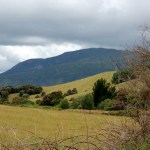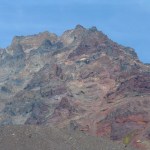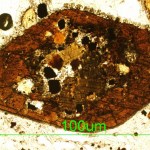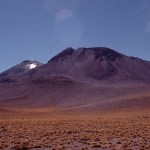Aucanquilcha
When we last left MVP, the latest entry actually did give people some trouble - but Don Crain ended up landing the winner at guess #15. The volcano is Ollagüe along the Chilean/Bolivian border. I took this shot from the road that comes up from the south towards Ollagüe (the town). Now, I have been to Ollagüe (the town) in almost 10 years now, but I did stay in a "hotel" called the Hotel Brin Bran - good soup, surly owner, nice view of both Ollagüe (the volcano) and Aucanquilcha. Definitely the vacation spot if you're visiting the high Andean Chilean/Bolivian frontier.
So, our standings:…
The northern Chilean and southern Peruvian Andes are full of volcanoes that look stunning - I mean, jaw-dropping details of volcanism litter the landscape. The reason for this is two fold: (1) there is an awful lot of volcanism in the northern Chilean/southern Peruvian Andes (as known as the Central Volcanic Zone) - and has been that way for over 10 million years and (2) it has also been very, very dry in the area (most of which is known as the Altiplano-Puna Plateau) for at least a few millions years as well - it is the home of the Atacama Desert! So, this means you get lots of volcanic…
So, I've had requests on the blog to help to do some defining of volcanologic terms on the blog, so I thought I'd try a new column called Eruptions Word of the Day. I'm not sure how often it will run, but let's give it a try.
Eruptions Word of the Day for July 5, 2010: Dacite
Dacite is a magma type defined by silica (SiO2) content between 63-68 (or 69) weight percent. That is the textbook definition, but some other typical characteristics of dacite lavas (or magmas) is the presence of certain minerals: plagioclase feldspar and hydrous minerals (containing water in their mineral structure)…
On advice of Eruptions reader Ekoh, I thought it would be fun to try to come up with a list of the most tongue-twisting and bizarre volcano names out there. I know there are a few out there that I've only typed once (the rest of the time I cut-and-paste), so lets review some recent fun ones:
Eyjafjallajökull (Iceland) - everyone's favorite tongue twister.
Eyjafjallajökull erupting in mid-May, 2010.
And people are still talking about the how the ash crisis was handled.
Kliuchevskoi (Russia) - It doesn't help that it has like ten names to boot (from the Smithsonian GVP):
KAMCHATSKAIA GORA…
As a volcanologist, I am partial to impressive lava flows, especially in volcanoes that erupt material that you'd think wouldn't produce big flows. For example, there are quite a few volcanoes in the Chilean Andes that erupt dacite lavas, which are relatively viscous (sticky), so you might expect it to erupt explosively. However, you can get large dacitic to rhyolitic lava flows, quite commonly, and these large flows are called coulées (a "volcanic dome flow").
Lllullaillaco volcano on the Chile/Argentina border. Note the very prominent coulée with flow levees. Click on the image to see a…
Folks have been suggesting that life on Earth started near volcanic vents for a long time now (and of course, some people don't buy it). Whether or not life sprung forth near hydrothermal vents, undersea black smokers or from the head of Zeus, it doesn't really change the fact that we find organisms living in these places today, expanding what we might consider "habitable" by leaps and bounds. Case and point, researchers from CU-Boulder have recently found a community of micro-organisms happily living near the summit of Volcán Socompa (above) in Chile in the hydrothermal vents. Now, having…




